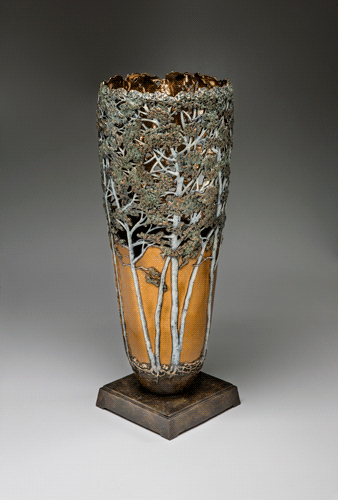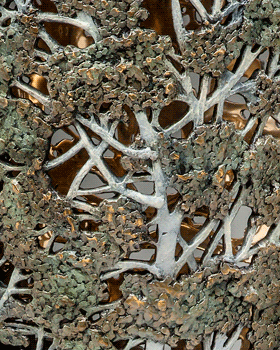edition of 45
28″ h x 11.5″ w
 Within the celestial woodlands
Within the celestial woodlands
Amongst the crackling echoes
Of creatures large and small
And the soothing, rustling of leaves
Aspen’s voice is joyfully perceived
Her strength and power is felt
Through her unending labyrinth
Of woven, generous roots
Roots that both wed and nourish
Her and her ancient family
Her journey focused
she continuously reaches u p w a r d
Delicately and unswervingly she grows
Simply toward the Light
Arms wrapped tightly around her indigenous family
When the storms rage
As rage they will
Her flexibility, tenacity and cooperation
Serve as her inherent survival tools
For her and for her blessed family
Her exterior scars – her wounds
She courageously wears on her bark
Do not hold her back – rather feed her
As she stretches proudly
Only toward the heavens

As the gentlest breeze
Rustles her leaves – her fingers
She instinctively sings
a calming, quaking lullaby
With her beloved family
Stirring
Capturing
Nourishing
Supporting
Inspiring
Loving
All her sacred Family
Through her
Voice of Wisdom
Inspiration
Voice of Wisdom was privately commissioned. In response to my clients request for a piece that spoke to the qualities of a warm, strong and loving family; we easily agreed upon the rich and welcome inspiration of the aspen tree.
 Voice of Wisdom celebrates the beautiful and wondrous analogy of the aspen tree to a strong and loving family unit enriched by its history. Individual aspen trees may live as long as 100 years; but living as clones and creating one organism within a grove, they are indeed thousands of years old. The grove’s roots are interconnected as they simply and consistently reach upward (or toward the Light). The same may well be true of our families, if we trace our roots (genealogy) and recognize our deep and ancient connectivity.
Voice of Wisdom celebrates the beautiful and wondrous analogy of the aspen tree to a strong and loving family unit enriched by its history. Individual aspen trees may live as long as 100 years; but living as clones and creating one organism within a grove, they are indeed thousands of years old. The grove’s roots are interconnected as they simply and consistently reach upward (or toward the Light). The same may well be true of our families, if we trace our roots (genealogy) and recognize our deep and ancient connectivity.
While sculpting the root system on the vessel into a delicate tapestry of intertwined life support growing only upward toward the Light, I focused on the hope that we will grow in our full awareness of our one larger, united family. At the same time, I held the intention that each of us, within our larger family, be reminded to hold the simple daily focus of reaching upward toward the Light.
Aspens grow as fast as possible without any regard to their highly visible wounds. This led me to reflect upon how we carry our supposed family ‘wounds’ – our stories – and how much attention or limitation we attribute to what we name ‘wound’. Aspen models a way of growing with and perhaps from these very wounds in deep and wondrous abundance.
Following a fire, they are the first to reappear and grow faster than most – giving attention to little other than simply growing as fast as they can. I asked myself, “am I able to survive the large and small ‘fires’ in my life/family by receiving them purely as ripe opportunities to grow and to grow as quickly as possible?”
Allowed by its unique, flat leaf/stem structure the leaves are able to flutter with the very slightest breeze. In high winds, the leaves clump together reducing air drag (which can easily break trunks) helping them survive violent storms despite their delicate structure. I effortlessly felt the rich truth in this survival tool. In catastrophes and challenges, we find ourselves best armored with friends and family; and with their hands tenderly interlocked in ours. In retrospect, we recognize the gift of oneness and unity in a way words defy. Again, I personally reflected on the times many hands, clasped together, kept dear ones and myself breathing and moving forward in the most challenging of times.
This same flexible, leaf structure gives voice to aspen’s familiar “quaking” as it enables them to bend and twist with the gentlest breeze resulting in a sweet, quaking lullaby. From our flexibility, grows sweet music – sweet music we create together.
A common clone is called “Pando” which means, I spread… What is it we might ask, that we each spread (offer) to and through our individual families? And, what is it we might subsequently spread to our larger single family?
Aspen is a marvelous, wise, rich and soulful inspiration. Her way of living and growing is a beautiful, loving blueprint of utter generosity, tenacity, cooperation, community, leadership and strength – a blueprint lived out fully in many families and my deep hope for all families. She is a beautiful model of a divinely loving family – a profound Voice of Wisdom.
The nine aspen trees on the vessel, a number symbolic of completion, suggests we are learning this integration of wisdom in our individual families, and bringing it to true fruition. When adding the numbers one through nine, the result is 45 – hence the edition size of 45.
Aspen Facts
- Aspen is in the willow family.
- Scientific name is Populus tremuloides (trembling poplar); common name – quaking aspen
- Aspen’s unique ‘quaking’ sound is created through its unique leaf / stem structure – the petiole is flat, as if pinched in along its length and attached at right angles to the leaf’s plane – fluttering in the slightest of breezes. In high wind the leaves clump together, reducing air drag that can easily break trunks and helping the aspens survive storms.
- Tall, straight (yet delicately curved or twisted on dryer land) trunks are almost the same diameter for at least half its length; horizontal branches are common (the more delicate ones often twist); narrow crown
- Leaves are almost circular with lustrous green on top and a silver underside; notably brilliant yellow in the autumn
- Very shallow, broad root system carrying a similarity tree to tree; coarse, thick, deeper roots are closer to the trunk; finer roots are EVERYWHERE – reaching upward toward the surface
- Mycorrhiza is a fungus root. By forming its mats of fungus in the poorest of soils, mycorrhiza mutually benefits both the tree and the fungus, allowing the tree to live and the fungus to survive.
- The aspen demands light. Its thin bark holds a natural sun screen. The outer layer is actually a living phloem and is capable of photosynthesis.
- Unconcerned about protecting its thin bark from insects and diseases, the aspen instead focuses on rapid growth.
- The bark is uniquely thin, smooth and white /cream colored. It contains salicin, a chemical closely related to aspirin (1998 Stuart Wier). Aspen’s vivid and numerous wounds heal into visible, black scars.
- The eye-shaped scars are visible remnants of a previous branch or a conk body of fungus shedding spores. Native Americans believe the scars as evidence of a bird flying into the tree never to return (creating the belief of special powers). Others claim they are the marks of bears claiming their territory and size.
- A critical characteristic of the aspen is its reproduction by sucker sprouts from a single trunk, root system (cloning). These new sucker sprouts may appear a great distance from the parent tree – meaning an entire, large grove is often one, single organism (such as the noted Pando in Utah, one of the most common clones meaning ‘I spread’). These sucker sprouts have the capacity of feeding water to others far away.
- Frequently the aspen groves grow near the edges of woodlands to more easily obtain greater light.
- Individual trees may be short lived (the typical life span is 100 years or less) but the groves are quite strong and vibrant with young aspens constantly appearing.
- Favorite food of beavers (inner bark), rabbits and deer; loved by hummingbirds and ruffed grouse
- Aspen’s soft wood is used for paper, matches, crates, fence posts, barn siding, a/c filters and most often paper.
- Needs only 7 inches of water per year to survive
- Most widely distributed tree in North America
